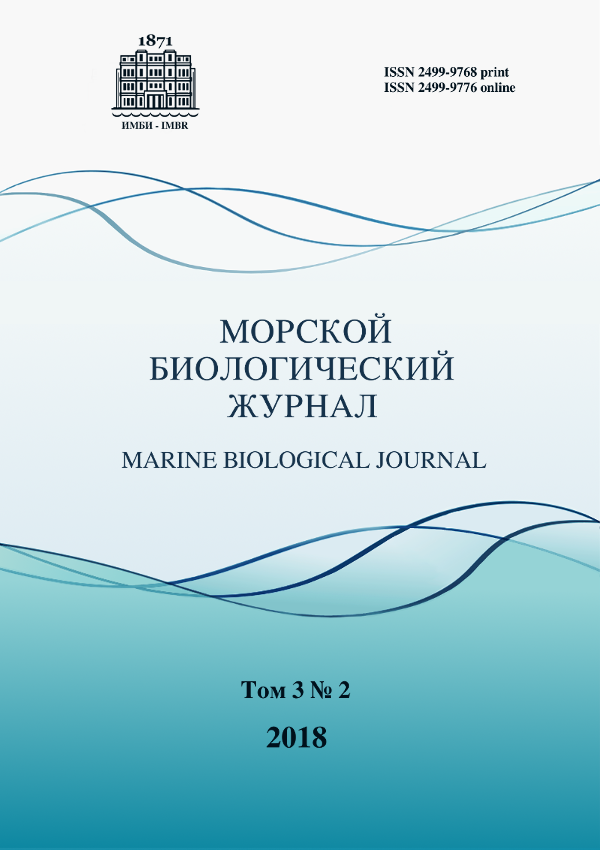Role of abiotic and biotic factors in formation of the seasonal variability of bioluminescence fields in the Sea of Azov
##plugins.themes.ibsscustom.article.main##
##plugins.themes.ibsscustom.article.details##
Abstract
More than 150 intensity profiles of the bioluminescence field at 4 hydrographic stations were obtained for the first time in the Sea of Azov. The profiles were performed with a discreteness of 1 m in depth, as well as temperature and electrical conductivity profiles; microplankton species composition was also analyzed. Measurements of vertical profiles of the photosynthetically active radiation were also made during daytime. Almost at all the stations, along with the bioluminescence field measurements, samples of microplankton were taken by Jedi nets and bathometers for subsequent analysis of its species composition and quantitative distribution. Studies were carried out in winter, spring and summer periods on a unified grid of stations. The pronounced seasonal variability of the bioluminescence field integral values and its vertical structure at the Sea of Azov was registered, that was determined by the superposition of biological and hydrological characteristics of the water column in the study areas. The minimum values of the bioluminescence field intensity at the Sea of Azov (6.05 × 10-12 W·cm-2·l-1 at a depth of 4 m) were recorded in winter period. It was mainly due to low water temperature of 0.5–1.5 °C in the late January and early February, that resulted in low abundance of luminous plankton. With spring warming up of water (at water temperature 12.5 °C) the development of the unicellular plankton intensified and an increase of the bioluminescence intensity in the bottom layer to 34.8 × 10-12 W·cm-2·l-1 was observed. In the summer period, maximum values of the bioluminescence intensity were registered (up to 634.4 × 10-12 W·cm-2·l-1) at average water temperature of 27.5 °C and at maximum abundance and biomass of the luminous phytoplankton fraction.
Authors
References
Битюков Э. П. Распределение и экология Noctiluca miliaris в Черном море // Биология моря. 1969. Вып. 17. С. 76–95. [Bityukov E. P. Raspredelenie i ekologiya Noctiluca miliaris v Chernom more. Biologiya morya, 1969, iss. 17, pp. 76–95. (in Russ.)].
Битюков Э. П. Биолюминесценция Noctiluca miliaris в разных температурных условиях // Биология моря. 1971. Вып. 24. С. 70–77. [Bityukov E. P. Biolyuminestsentsiya Noctiluca miliaris v raznykh temperaturnykh usloviyakh. Biologiya morya, 1971, iss. 24, pp. 70–77. (in Russ.)].
Гительзон И. И., Левин Л. А., Утюшев Р. Н., Черепанов О. А., Чугунов Ю. В. Биолюминесценция океана. Санкт-Петербург : Гидрометеоиздат, 1992. 283 с. [Gitel’zon I. I., Levin L. A., Utyushev R. N., Cherepanov O. A., Chugunov Yu. V. Biolyuminestsentsiya okeana. Saint Petersburg : Gidrometeoizdat, 1992, 283 p. (in Russ.)].
Дацко В. И. Точный ход кислорода и биомассы фитопланктона в Азовском море // Доклады АН СССР, Новая серия. 1940. Т. 27, № 1. С. 75–77. [Datsko V. I. Tochnyi khod kisloroda i biomassy fitoplanktona v Azovskom more. Doklady AN SSSR, Novaya seriya, 1940, vol. 27, no. 1, pp. 75–77. (in Russ.)].
Токарев Ю. Н. Основы биофизической экологии гидробионтов. Севастополь : ЭКОСИ-Гидрофизика, 2006. 342 с. [Tokarev Yu. N. Osnovy biofizicheskoi ekologii gidrobiontov. Sevastopol : EKOSI-Gidrofizika, 2006, 342 p. (in Russ.)].
Токарев Ю. Н., Василенко В. И., Жук В. Ф. Новый гидробиофизический комплекс для экспрессной оценки состояния прибрежных экосистем // Современные методы и средства океанологических исследований : материалы XI Междунар. науч.-техн. конф., 25–27 ноября 2009, Москва. Москва : Изд-во РАН, 2009. Ч. 3. С. 23–27. [Tokarev Yu. N., Vasilenko V. I., Zhuk V. F. Novyy gidrobiofizicheskii kompleks dlya ekspressnoi otsenki sostoyaniya pribrezhnykh ekosistem. In: Sovremennye metody i sredstva okeanologicheskikh issledovanii: materialy XI Mezhdunar. nauch.-tekhn. konf., 25–27 Nov., 2009, Moscow. Moscow: Izd-vo RAS, 2009, pt. 3, pp. 23–27. (in Russ.)].
Токарев Ю. Н., Евстигнеев П. В., Машукова О. В. Планктонные биолюминесценты Мирового океана: видовое разнообразие, характеристики светоизлучения в норме и при антропогенном воздействии. Симферополь : Н. Орiанда, 2016. 347 с. [Tokarev Yu. N., Evstigneev P. V., Mashukova O. V. Planktonnye biolyuminestsenty Mirovogo okeana: vidovoe raznoobrazie, kharakteristiki svetoizlucheniya v norme i pri antropogennom vozdeystvii. Simferopol : N. Orianda, 2016, 347 p. (in Russ.)].
Токарев Ю. Н., Битюков Э. П., Василенко В. И., Соколов Б. Г. Поле биолюминесценции – характерный показатель структуры планктонного сообщества Черного моря // Экология моря. 2000. Вып. 53. С. 20–25. [Tokarev Yu. N., Bityukov E. P., Vasilenko V. I., Sokolov B. G. Pole biolyuminestsentsii – kharakternyy pokazatel’ struktury planktonnogo soobshchestva Chernogo morya. Ekologiya morya, 2000, iss. 53, pp. 20–25. (in Russ.)].
Yentsch C. S., Plinney D. A. A bridge between ocean optics and microbial ecology. Limnology and Oceanography, 1989, vol. 34, iss. 8, pp. 1694–1705. https://doi.org/10.4319/lo.1989.34.8.1694.
Tokarev Yu. N., Bityukov E. P., Williams R., Vasilenko V. I., Piontkovski S. A., Sokolov B. G. The bioluminescence field as an indicator of the spatial structure and physiological state of the planktonic community at the Mediterranean Sea basin. In: Malanotte-Rizzoli P., Eremeev V. N. (Eds). The Eastern Mediterranean as a Laboratory Basin for the Assessment of Contrasting Ecosystems. Dordrecht : Springer, 1999, pp. 407–416. (NATO Science Series ; Series 2: Environmental Security, vol. 51). https://doi.org/10.1007/978-94-011-4796-5_26.


 Google Scholar
Google Scholar



